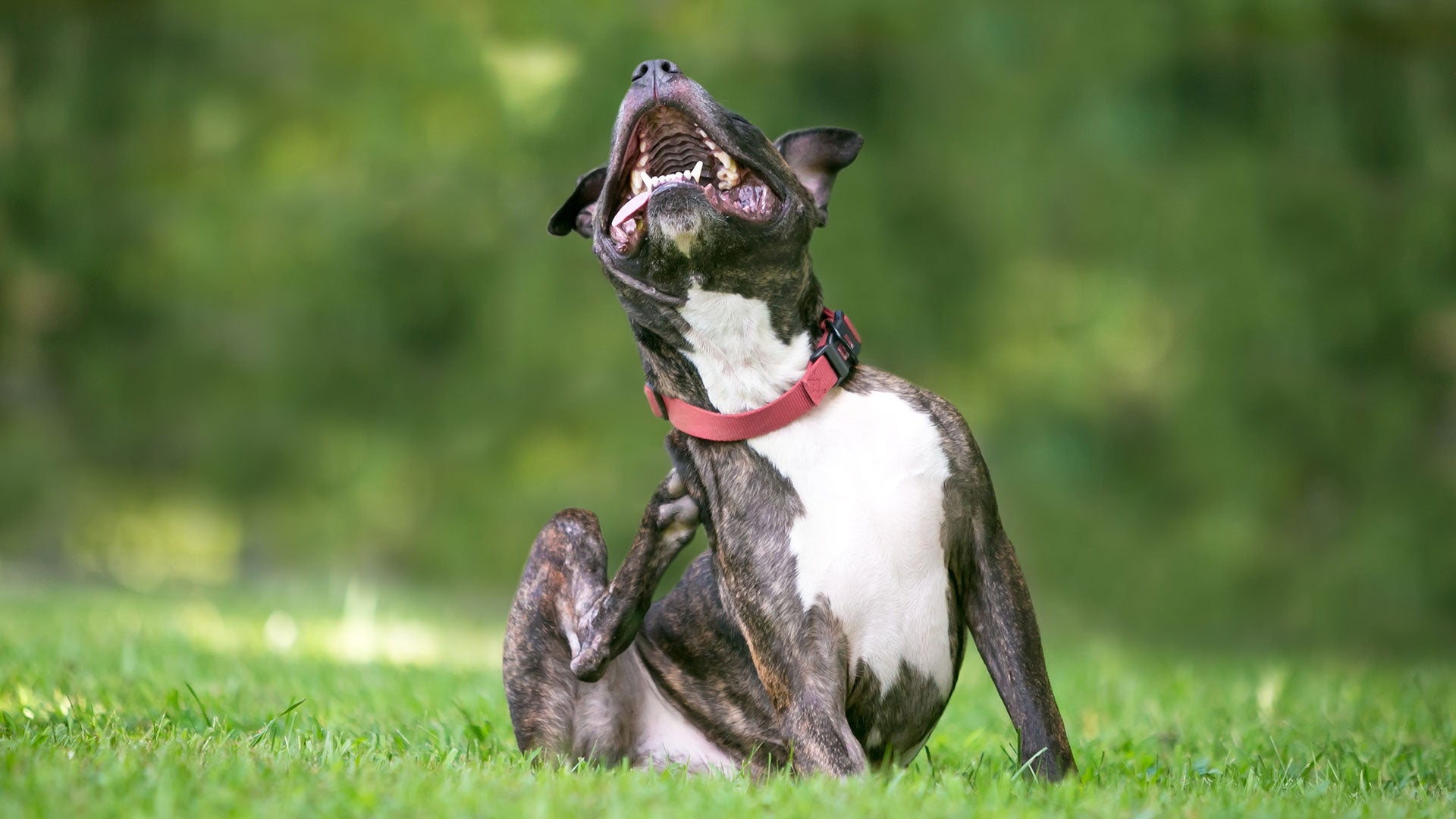Spring is in the air, and you and your dog are just itching to soak up the sun and stretch your legs outside. But the warmer weather also means the chances that your beloved pup will bring back hitchhiking pests are higher, particularly after a romp in the woods. Though, the great outdoors isn’t the only place dogs can encounter fleas and ticks. Pests like fleas and ticks can even be found in urban areas like cities. While fleas thrive in warmer weather, they are experts at adapting and hide indoors when temperatures drop. So unlike tick season, when “flea season” is over your pets can still be at risk for flea infestation. But don’t worry, we’ll share all-natural solutions that will help you beat the bites and keep your home pest-free.

Reducing the Risk of Infestation
Regular yard maintenance will keep fleas and ticks at bay. Keeping your grass trimmed looks nice and makes it less hospitable, as ticks prefer tall grass. You can also keep pests off your lawn with diatomaceous earth (DE). DE is a pet and human-safe naturally-occurring powder that dries out the exoskeleton of bugs and pests. Make sure to purchase food-grade DE only, as filter-grade can be hazardous.
Though non-toxic, DE can cause skin drying and coughing if inhaled in large amounts. As a preventative measure wear gloves and a mask when applying. Sprinkle in areas where pests can hide, like tall grasses, under the sofa, carpets, rugs, hardwood floors, and around baseboards. After a couple of days vacuum excess powder, and repeat as needed.
Keeping your pet and home spic and span is also an effective measure for tackling pests before they become a pain. Regularly bathing your dog using flea shampoo is a great way to prevent infestations. Fleas love to burrow in carpets and rugs so vacuuming can help. Though your home is not pest immune if it’s carpet and rug-free. Flea eggs can fall off your pet and get stuck in wood cracks and pitted areas of tile. Cleaning often, especially under furniture and less traveled areas should do the trick. The thought of fleas or ticks in your bed is nightmare-inducing. Wash sheets, blankets, and all pet bedding frequently so you and your beloved pup can rest easy.

Send Pests Packing
It’s impossible to completely eliminate the risk of encountering fleas and ticks. The prevention measures mentioned above combined with frequent pest monitoring will keep your dog healthy and safe. If you find fleas or ticks in your dog’s fur, early removal is important for reducing the risk of disease that pests can carry.
Ticks are about the size of an apple seed, so you should feel a bump when you run your fingers through your dog’s fur. Don’t forget to check their feet (including between their toes), inside their ears, and around the face and neck. If you feel a bump, gently part your dog’s fur and keep an eye out for a black, brown, or grayish-brown bug.
To remove the pest safely, make sure you’re wearing a pair of gloves. Find the tick again. Then using fine-point tweezers, grab the tick gently pulling straight upward, in a slow, steady motion. If you’re using a tick removal tool put the “forked” part under the bug, close to the skin. Slowly turn the tool in a clockwise motion several times.
Dispose of a live tick by putting it in alcohol, placing it in a sealed bag/container, or flushing it down the toilet. Clean the bite and the skin around it with antiseptic, or antibiotic ointment. Then wash your hands, clean the bite site with rubbing alcohol, and wipe the tools with disinfectant. Tick bites can cause general health issues in pets such as weakness, exhaustion, vomiting, and decreased appetite, so call your vet if your dog exhibits any of these symptoms.
Fleas are a lot smaller and move more, so they might be harder to find. Itching and scratching, redness, flaky skin, scabs, hot spots, hair loss (especially around the tail area) are all signs of fleas. You may also see “flea dirt,” tiny dark spots of digested blood. If your dog is chewing and scratching at a spot, fleas are a likely cause.
You can remove ticks by brushing your dog’s fur with a flea comb. Fleas tend to feed around the neck and the tail so take extra care in those areas. If you see fleas on the comb, dunk the comb into warm soapy water to kill them.
The Benefits of Natural Pet Products
There are tons of products geared towards preventing and treating fleas and ticks, but not all products are created equal. Many use chemical pesticides which can irritate your dog’s skin if used ineffectively. The FDA also warns pet owners to be wary of treatments in the isoxazoline class, which includes certain pills and chews. These have been known to cause adverse effects like muscle tremors, ataxia, and seizure. If you choose chemical treatments, it’s important to speak with your vet to determine which are safe and designed specifically for your pet’s health.
Alternatively, there are natural solutions such as essential oil-based sprays and shampoos. Fleas and ticks detest the smell of essential oils, so if you can smell the spray your pet is safe from pests. Spray weekly during flea and tick high season or before any hikes or woodland adventures. Many flea and tick shampoos contain harsh chemicals that can make irritation and infections worse. Using a natural essential oil-based shampoo can be a gentler option for prevention and pest removal.
Flea and tick prevention is important for ensuring your dog’s comfort and health. It will also make sure you and your family from contracting tick or flea-borne disease and keep your home infestation free. So now that you’ve learned how to naturally prevent and treat fleas and ticks, go out and enjoy the warmer weather, climb every mountain, and explore the wilderness without letting fear of pests hold you or your furry pal back.



